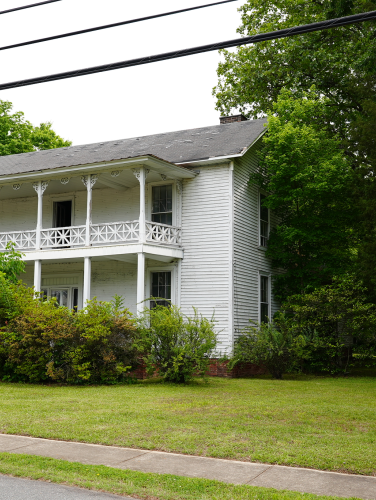
Charles Alexander House
(ca. 1880)
The Alexander House is a unique example on an “in-town” I-house with Folk Victorian decoration.
203 Church St., Huntersville, NC 28078
The 1880s construction of the Charles and Laura Alexander House occurred during a period of substantial growth in Huntersville. Because of its strategic location beside what was then the Atlantic, Tennessee & Ohio Railroad line from Charlotte to Statesville, the town expanded rapidly in the late nineteenth century. That growth was aided by the 1890s opening of the Anchor Mills, part of the contemporaneous cotton mill campaign that gripped the Piedmont section of the Carolinas during that time. The mainstay of Huntersville's economy, however, were the owners of the modest farms that surrounded the town.
Property Quick Links
The Alexander House is a notable example of the "in-town" version of the two-story, extended I-house with center hall that was common in the post-railroad years between approximately 1850 to 1890, often referred to as the National Folk House period. The house is embellished with Folk Victorian decoration on the front porch, setting it apart on a street of simpler houses.
The earliest known residents of the Alexander House were the Hunter family. J. N. Hunter was a typical small-scale farmer. He owned thirty tilled acres and two unimproved acres. Although he diversified his crops – including Indian corn, wheat, and Irish potatoes and sweet potatoes – he primarily cultivated the prevalent cash crop of cotton. Like many of his neighbors in and around Huntersville, Hunter employed no tenant farmers or sharecroppers, relying instead upon the labor of his family for the farm’s operation. In addition to farming, Hunter also served as the community’s postmaster.
Charles and Laura Alexander acquired the property in 1890. Charles also farmed the property, as well as other nearby parcels. The Alexander family maintained ownership of the house until 1925, when it was sold to W. W. and Minnie Lee Brown. Subsequent owners of the house included the brothers C. S. and S. W. Davis – owners of the Davis General Store in nearby Croft that supplied area farmers with dry goods and other provisions – and the family of I. I. and Annabelle Earnhardt.

